My first taste of Hardinera was during a high school field trip to Lucban, Quezon. While everyone was busy buying colorful kiping and pancit hab-hab, our tour guide insisted we try this local meatloaf that she said would change how we think about fiesta food forever.
She was right! Unlike the embutido I grew up with, this Hardinera was a revelation: tender chunks of braised pork mingling with sweet pineapple and savory cheese, all beautifully layered with boiled eggs and bell peppers.
After years of perfecting this recipe in my own kitchen, I can tell you that while Hardinera might look intimidating, it's actually a forgiving dish that rewards patience with incredible flavor.
It's more than just a meatloaf, it's a piece of Quezon's heritage that deserves a place in every Filipino home cook's recipe collection.
Jump to:
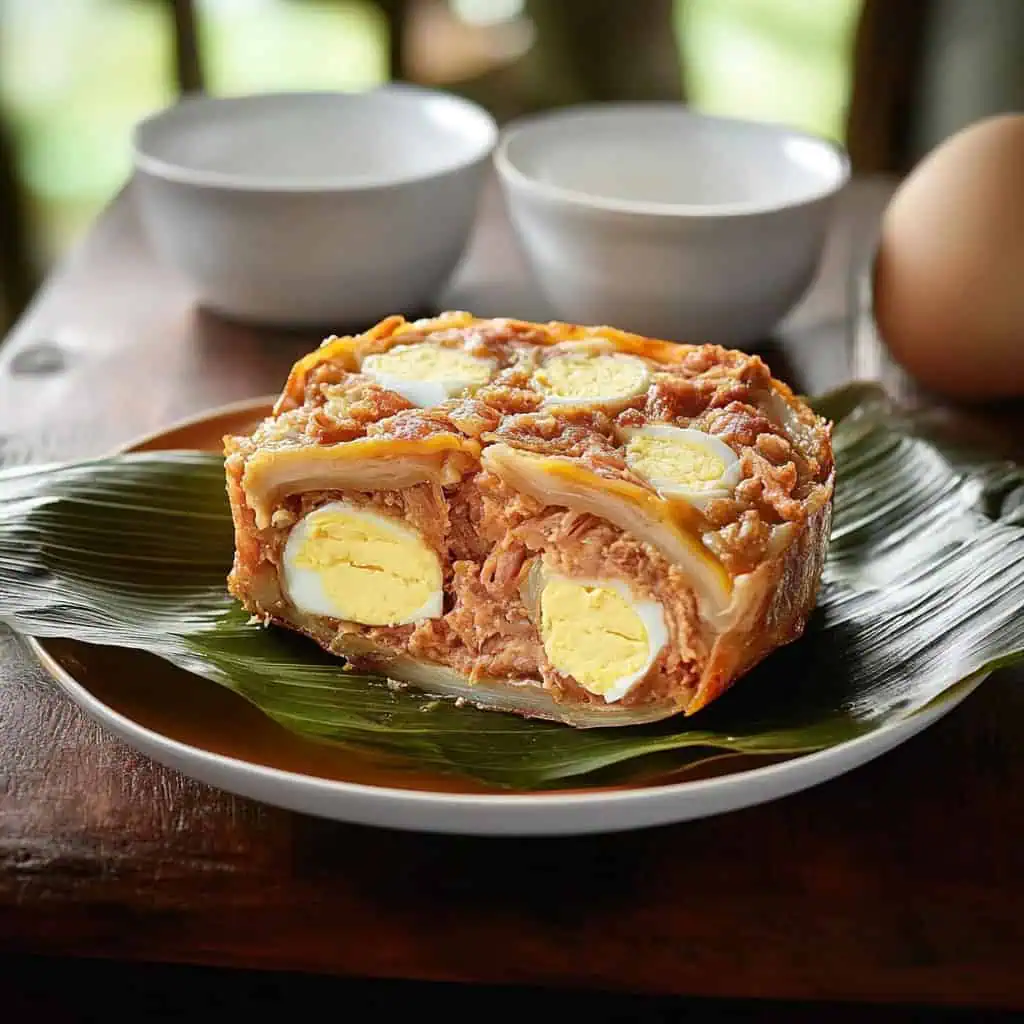
Why You'll Love This Recipe
- Perfect make-ahead dish for special occasions
- Impressive presentation with colorful layers
- Balanced sweet and savory flavors
- Feeds a crowd (serves 12)
- Better than traditional embutido
- Freezer-friendly
- No fancy ingredients needed
Ingredients
Each component in Lucban Hardinera plays a crucial role in creating its distinctive flavor profile. The pork butt provides a tender, flavorful base, while the combination of tomato ketchup and paste creates a rich, tangy foundation.
Sweet elements (pineapple, raisins, and sugar) balance the savory meat and cheese, creating the signature sweet-savory contrast that defines this dish. The eggs act as a binding agent that holds everything together during steaming, while the colorful garnishes transform this meatloaf into a festive centerpiece worthy of special occasions.
This thoughtful combination reflects Lucban's culinary heritage - practical yet celebratory.
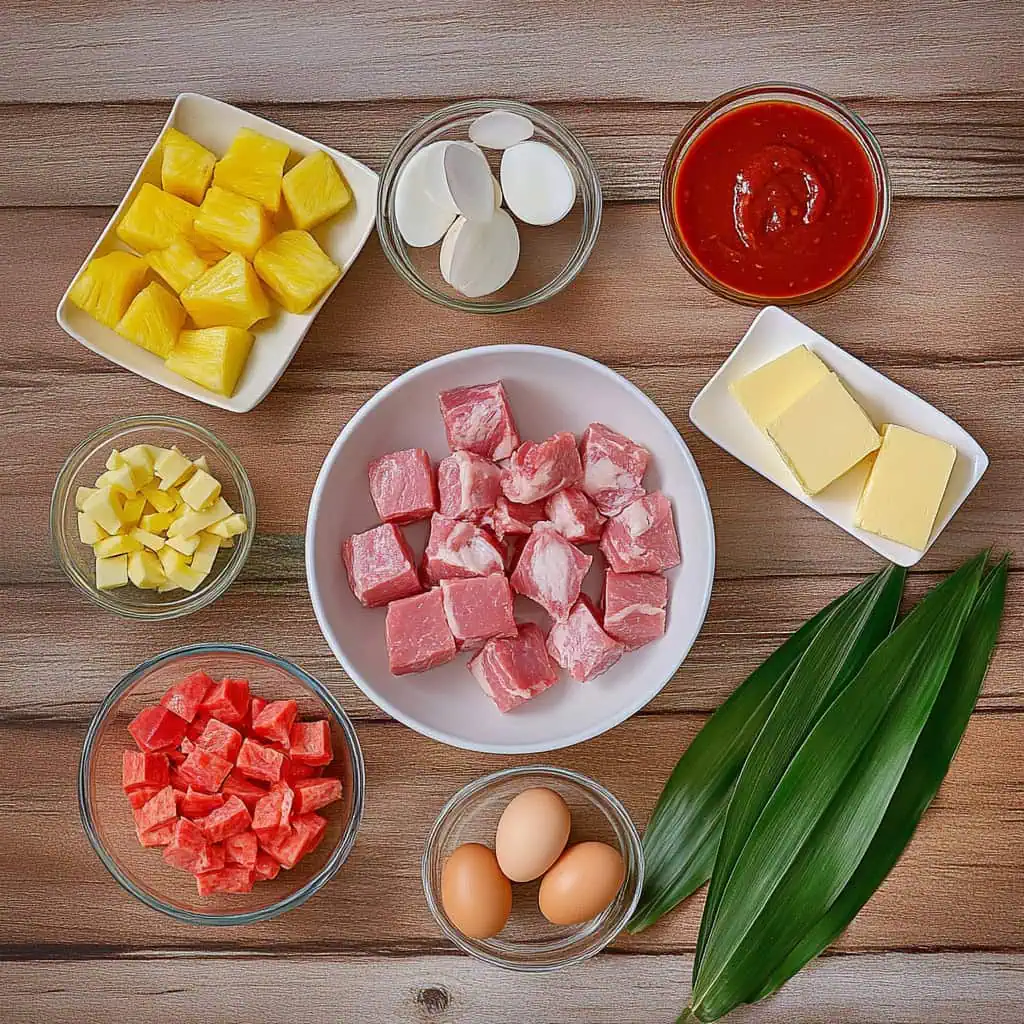
For the Meat Base:
- 2 pounds pork butt (kasim), cut into small cubes
- 1 large onion, sliced
- 6 cloves garlic, crushed
- 2 cups tomato ketchup
- 2 tablespoons tomato paste
- Salt to taste
- Water
For the Filling:
- 2 tablespoons cooking oil
- 1 small onion, finely chopped
- 2 cloves garlic, minced
- 1 large red bell pepper, chopped
- 1 cup luncheon meat, diced
- 1 cup pineapple tidbits
- 1 cup cheese, shredded
- ¼ cup sweet pickle relish
- 2 tablespoons raisins
- 1 teaspoon sugar
- 4 eggs, well beaten
- Butter for greasing
For Garnish:
- 4 pineapple slices, halved
- 2 hard-boiled eggs, sliced
- Carrot florets
- Red bell pepper strips
- Banana leaves for lining
Equipment
- 3 Llaneras (oval Filipino molds): Traditional molds that give Hardinera its classic shape and allow for proper steaming. If unavailable, loaf pans can work as an alternative.
- Large Steamer or Stockpot with Rack: Essential for the final cooking stage, ensuring the meatloaf sets properly without becoming waterlogged.
- Heavy-Bottom Pot: For braising the pork properly, allowing even heat distribution for tender meat.
- Wide Skillet: Used for cooking the meat mixture and reducing excess liquid before molding.
- Sharp Knife: Ensures uniform cutting of ingredients, which is important for even cooking and appealing presentation.
- Cutting Board: Provides a stable surface for proper ingredient preparation.
- Mixing Bowls: Several sizes needed for organizing ingredients and combining components.
- Measuring Cups and Spoons: For accurate measurements, crucial for proper texture and flavor balance.
- Meat Thermometer: Helps verify the Hardinera has reached a safe internal temperature of 160°F/71°C.
- Aluminum Foil: Used to cover the molds during steaming, preventing water from dripping onto the mixture.
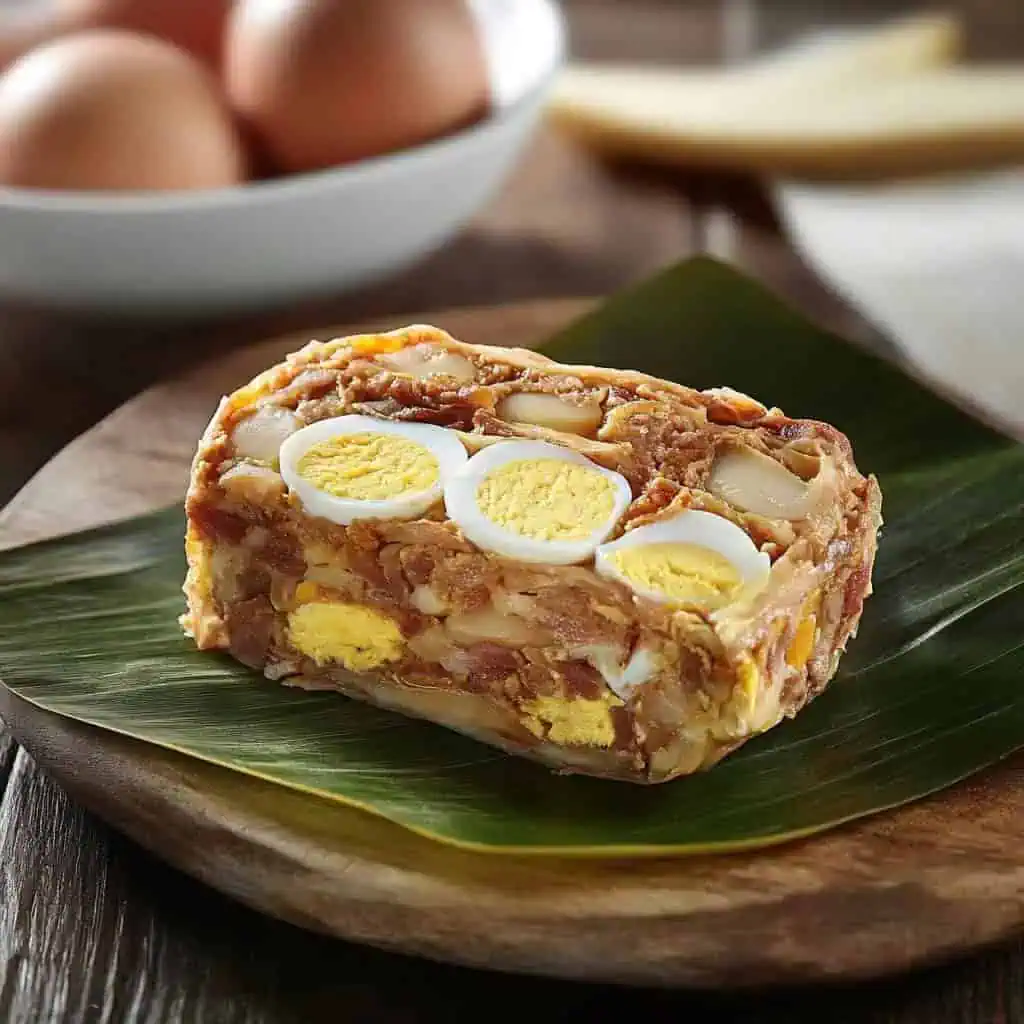
How To Make
- Prepare Your Equipment: Heat your steamer with enough water to last through the cooking process. While waiting for it to heat, prepare three llaneras by greasing them thoroughly with butter and lining each with banana leaves.
- Braise the Pork: Rinse the pork and cut it into four large pieces. In a large pot, combine the pork, sliced onion, crushed garlic, 1 cup of tomato ketchup, 1 tablespoon tomato paste, 1 teaspoon salt, and enough water to cover. Bring to a boil over high heat.
- Remove Impurities: When the mixture boils, skim off the gray foam that rises to the surface. Reduce heat, cover, and simmer for 1 to 1½ hours until the meat can be easily pierced with a fork.
- Prepare the Pork: Remove the pork from the broth and allow it to cool until comfortable to handle. Cut into small, uniform cubes.
- Create the Filling Base: Heat oil in a large pan. Sauté chopped onion and minced garlic until fragrant and translucent. Add the remaining ketchup and tomato paste, cooking for one minute to develop flavor.
- Combine Filling Ingredients: Add the cubed pork, diced luncheon meat, chopped bell peppers, sweet pickle relish, shredded cheese, pineapple tidbits, raisins, and sugar. Season with salt and add about ½ cup of water. Cook until most of the liquid evaporates.
- Cool the Mixture: Transfer to a bowl and allow to cool completely. This is crucial as a hot mixture will prematurely cook the eggs when added.
- Prepare Decorative Elements: While the mixture cools, arrange decorative elements in your prepared llaneras. Place slices of hard-boiled eggs, pineapple, bell pepper strips, and carrot florets in an attractive pattern on the banana leaves.
- Add First Egg Layer: Beat 4 eggs thoroughly in a bowl. Take half of this mixture and divide it among the three llaneras, pouring it over your arranged decorations.
- Add Meat Mixture: Once completely cooled, divide the meat mixture evenly between the three llaneras. Press down firmly with the back of a spoon to eliminate air pockets and create a smooth, even surface.
- Add Final Egg Layer: Pour the remaining beaten eggs over the meat mixture in each llanera, ensuring complete coverage.
- Steam the Hardinera: Cover each llanera tightly with aluminum foil. Place in the steamer and cook for 30-40 minutes until the mixture is firm and has reached an internal temperature of 160°F/71°C.
- Rest Before Serving: After steaming, allow the meatloaves to rest for 8-10 minutes. Serve hot, or better yet, refrigerate for an hour until cold for cleaner slices.
- Unmold and Serve: Run a knife around the edges of each llanera. Place a serving plate on top and quickly flip to unmold. Carefully peel away the banana leaf. Slice and serve with rice.

Tips from Lola's Kitchen
- Choose the Right Cut: Use pork with some fat marbling (like kasim/pork butt) for better flavor and juiciness. Too lean cuts can make the Hardinera dry.
- Precise Cutting Matters: Cut all ingredients into uniform sizes for even cooking and better texture in every bite.
- Proper Cooling is Essential: Always cool the meat mixture completely before adding eggs. Hot mixture will begin cooking the eggs prematurely, resulting in an uneven texture.
- Remove Air Pockets: When filling the llaneras, press down firmly on the mixture to eliminate air bubbles which can cause your Hardinera to have holes or collapse after steaming.
- Banana Leaf Technique: Quickly pass banana leaves over an open flame before using them - this makes them more pliable and releases their aroma, adding to the traditional flavor.
- Steaming Temperature: Maintain a gentle but consistent steam throughout cooking. Too vigorous boiling can make the Hardinera tough, while insufficient steam will prevent proper setting.
- Perfect Timing: Test for doneness by inserting a toothpick in the center - it should come out clean. Undercooked Hardinera will be soggy, while overcooked will be dry.
- Resting Period: The 10-minute rest after steaming is non-negotiable. This allows the proteins to set properly, making unmolding cleaner and slices neater.
- Overnight Enhancement: For the best flavor, make Hardinera a day ahead and refrigerate overnight. The flavors will meld beautifully, and cold Hardinera slices more neatly.
- Decoration Strategy: Place decorative elements thoughtfully, considering how they'll look when unmolded. Remember that what goes on the bottom of the llanera becomes the top presentation.
Substitutions
- Pork Alternative: Ground beef or chicken thighs can replace pork, though cooking times may vary. For beef, add a little more fat for moisture.
- Luncheon Meat Options: Ham, bacon, or hotdogs can substitute for luncheon meat. Each brings a different but complementary flavor profile.
- Cheese Variations: While quesong puti (white cheese) is traditional, any melting cheese works well. Try cheddar for sharpness or mozzarella for stretchiness.
- Banana Leaf Replacements: If banana leaves aren't available, parchment paper works as a functional alternative, though you'll miss the aromatic benefit.
- Pineapple Options: Fresh pineapple can replace canned tidbits. If using fresh, choose ripe but firm fruit and cut into small, uniform pieces.
- Sweetener Alternatives: Brown sugar or honey can replace white sugar for a deeper sweetness. Reduce amount by 25% if using honey.
- Tomato Base Substitutions: In place of ketchup, you can use tomato sauce with a tablespoon of sugar added. For tomato paste, reduce 3 tablespoons of tomato sauce until thick.
- Llanera Alternatives: If llaneras aren't available, small loaf pans or heat-resistant glass containers work, though traditional shape will be lost.
Troubleshooting
Hardinera Not Setting Properly
- Problem: Mixture remains soft or liquid in center after cooking
- Solutions:
- Ensure excess liquid was properly evaporated before molding
- Check steamer has consistent, adequate heat
- Verify eggs were properly beaten and incorporated
- Steam for additional 5-10 minutes if needed
Difficult to Unmold
- Problem: Hardinera sticks to mold or breaks when unmolding
- Solutions:
- Ensure molds were thoroughly greased
- Confirm banana leaves covered entire surface
- Allow proper cooling time before unmolding
- Run a thin knife around edges before flipping
Uneven Texture
- Problem: Some parts firm, others soggy
- Solutions:
- Cut ingredients more uniformly
- Mix components more thoroughly
- Ensure steamer maintains consistent temperature
- Rotate llaneras midway through cooking if your steamer has hot spots
Flavor Too Sweet or Too Acidic
- Problem: Unbalanced taste profile
- Solutions:
- For too sweet: Reduce sugar, pineapple, or raisins in next batch
- For too acidic: Add a pinch more sugar or reduce tomato components
- Balance with more cheese for richness if needed
Decorative Elements Shifting
- Problem: Garnishes move during steaming
- Solutions:
- Ensure first egg layer properly covers decorations
- Let egg layer set slightly before adding meat mixture
- Handle filled llaneras gently when transferring to steamer
Storage & Reheating
Refrigeration
- Store cooled Hardinera in an airtight container for up to 5 days
- For best quality, consume within 3 days
- Keep sliced and whole portions separately wrapped to preserve moisture
Freezing
- Freeze fully cooled Hardinera wrapped in plastic wrap then aluminum foil
- Label with date and use within 2 months
- Freeze in portions for easier thawing if desired
Thawing
- Thaw frozen Hardinera overnight in the refrigerator for best texture
- Quick thaw methods not recommended as they can make the texture soggy
Reheating Methods
- Steaming: The best method to preserve moisture. Steam for 10-15 minutes until heated through
- Microwave: Place slice on microwave-safe plate, cover with damp paper towel, heat on medium power for 1-2 minutes
- Pan-Frying: For a different texture, lightly fry slices in a non-stick pan with minimal oil until heated through and slightly crisp on edges
- Oven: Wrap in foil and heat at 325°F for 10-15 minutes (not recommended for thin slices as they may dry out)
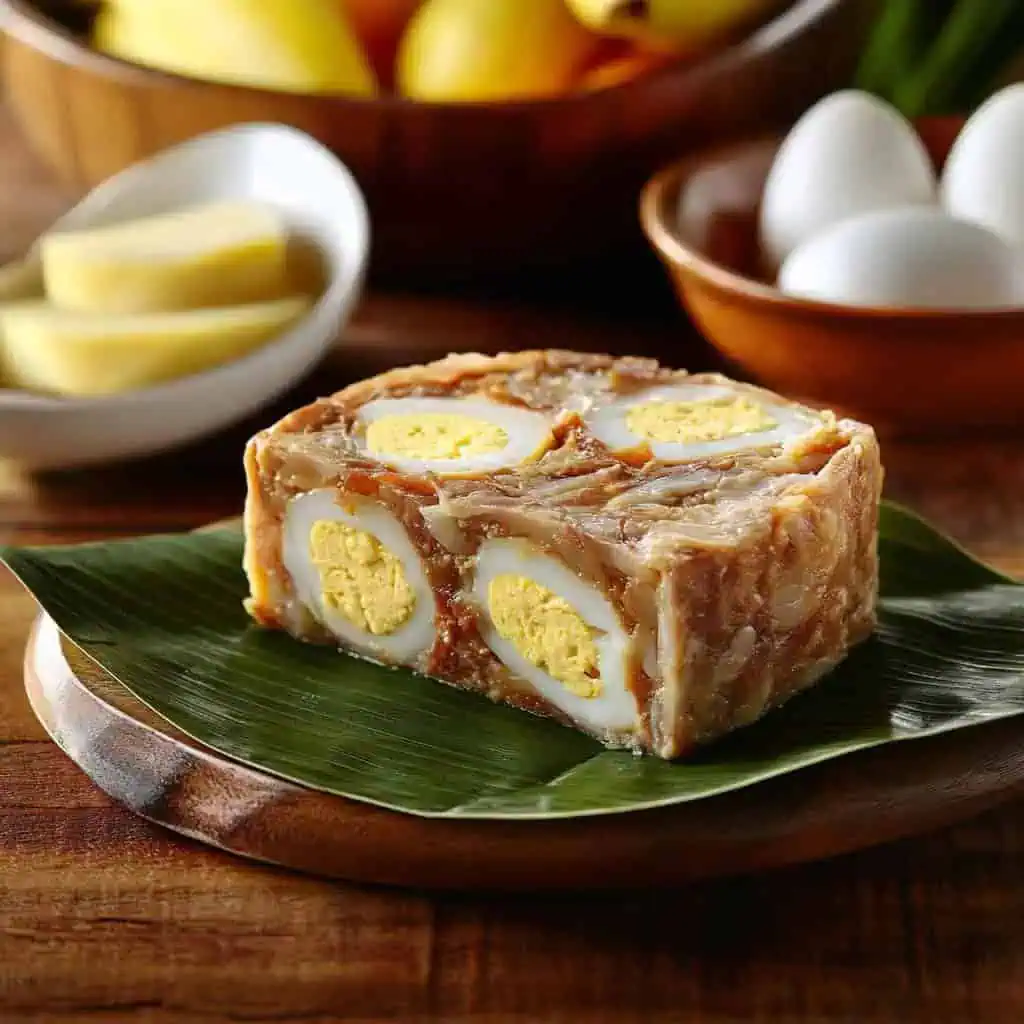
FAQ
Can I make Lucban Hardinera ahead of time?
Yes, Hardinera actually improves with time as flavors meld. You can prepare it up to 2 days in advance and refrigerate until needed. Many families in Lucban make it the day before special occasions.
Why is braising the pork first so important?
Braising develops deeper flavors and ensures tender meat. This double-cooking method (braising then steaming) is what sets Hardinera apart from other Filipino meatloaves like embutido.
Why use banana leaves?
Banana leaves serve three purposes: they prevent sticking, impart a subtle aroma that's quintessentially Filipino, and create an authentic presentation. They're traditional to Lucban cooking methods.
Can I use a regular steamer instead of the traditional llanera method?
Yes, any steaming setup works as long as you have molds that can withstand the heat and moisture. The traditional oval llaneras create the distinctive shape, but loaf pans produce excellent results too.
How do I know when my Hardinera is fully cooked?
A properly cooked Hardinera should reach an internal temperature of 160°F/71°C. It should feel firm when gently pressed in the center, and a toothpick inserted in the middle should come out clean.
Can I serve Hardinera cold?
Absolutely! In fact, many Filipinos prefer Hardinera cold, especially during hot weather. Chilled Hardinera slices more cleanly and the flavors are more pronounced.
What's the difference between Hardinera and Embutido?
The main differences are that Hardinera uses braised pork (not raw ground meat), incorporates cheese, features a decorative presentation, and is always steamed in llaneras with banana leaves.
Can I reduce the sweetness without affecting the authentic taste?
Yes, you can reduce the sugar and pineapple slightly while increasing savory elements like cheese. The sweet-savory balance is important, but can be adjusted to personal preference.
How spicy is traditional Hardinera?
Traditional Hardinera is not spicy. However, some families add chopped red chilies for heat. You can add 1-2 finely chopped red chilies to the mixture if you prefer a spicier version.
Can I make a smaller batch?
Yes, simply divide all ingredients by three to make a single llanera. The cooking time remains the same, but yields approximately 4 servings instead of 12.
Related
Looking for other recipes like this? Try these:

Lucban Hardinera (Quezon's Special Festive Meatloaf)
Equipment
- 3 llaneras (Filipino oval molds) for shaping and steaming the meatloaf
- Large steamer or stockpot with steamer rack for cooking the hardinera
- Heavy-bottom pot for braising the pork
- Wide skillet for cooking the meat mixture
- Sharp knife for uniform cutting of ingredients
- Cutting board for prep work
- Mixing bowls for combining ingredients
- Measuring cups and spoons for accurate measurements
- Meat thermometer to ensure proper cooking temperature
- Aluminum foil for covering while steaming
Ingredients
For the Meat Base:
- 2 pounds pork butt kasim [baboy na kasim], cut into small cubes
- 1 large onion [sibuyas] sliced
- 6 cloves garlic [bawang] crushed
- 2 cups tomato ketchup [ketsap]
- 2 tablespoons tomato paste [pino na kamatis]
- Salt [asin] to taste
- Water [tubig]
For the Filling:
- 2 tablespoons cooking oil
- 1 small onion finely chopped
- 2 cloves garlic minced
- 1 large red bell pepper [pamintang pula] chopped
- 1 cup luncheon meat diced
- 1 cup pineapple tidbits [pinya]
- 1 cup cheese [keso] shredded
- ¼ cup sweet pickle relish
- 2 tablespoons raisins [pasas]
- 1 teaspoon sugar [asukal]
- 4 eggs [itlog] well beaten
- Butter [mantikilya] for greasing
For Garnish:
- 4 pineapple slices halved
- 2 hard-boiled eggs sliced
- Carrot florets [karot]
- Red bell pepper strips
- Banana leaves [dahon ng saging] for lining
Instructions
- Heat your steamer with enough water and get it ready while you prepare everything else.
- Get three llaneras and grease them well with butter. Line each one with banana leaves and set them aside.
- Start with the pork. Rinse it well and cut it into four large pieces. In a large pot, put the pork, 1 sliced onion, 6 crushed garlic cloves, 1 cup tomato ketchup, 1 tablespoon tomato paste, 1 teaspoon salt, and enough water to cover everything. Turn the heat to high and let it start boiling.
- When it boils, you'll see gray foam on top. Scoop this out with a spoon and throw it away. Lower the heat, put the lid on, and let it cook slowly for about 1 to 1½ hours until the meat is tender enough to pierce easily with a fork.
- Take the pork out and let it cool until you can handle it. Cut it into small, even-sized cubes.
- Heat 2 tablespoons of oil in a large pan. Add 1 chopped onion and 2 minced garlic cloves. Cook until they become soft and smell good.
- Add the remaining 1 cup of ketchup and 1 tablespoon of tomato paste. Stir and cook for a minute.
- Now add your cubed pork, the diced luncheon meat, chopped bell peppers, sweet pickle relish, shredded cheese, pineapple tidbits, raisins, and 1 teaspoon sugar. Add a little salt to taste. Pour in about ½ cup of water and cook until most of the liquid is gone.
- Put this mixture in a bowl and let it cool completely. This is important because hot mixture will cook the eggs we'll add later.
- While waiting, decorate your prepared llaneras. Arrange slices of hard-boiled eggs, pineapple slices, bell pepper strips, and carrot florets on the banana leaves to make it pretty.
- Break 4 eggs into a bowl and beat them really well. Take half of these beaten eggs and divide them among the three llaneras, pouring over your arranged decorations.
- Once your meat mixture is completely cool, divide it between the three llaneras. Press it down firmly with a spoon to remove air bubbles. Make the top smooth and even.
- Pour the remaining beaten eggs over the meat mixture in each llanera, making sure to cover everything.
- Cover each llanera tightly with aluminum foil. Put them in your steamer and cook for 30-40 minutes until firm.
- After steaming, let them rest for 8-10 minutes. You can serve them right away while hot, or better yet, put them in the refrigerator for an hour until cold.
- To serve, run a knife around the edges of the llanera. Put your serving plate on top and quickly flip it over. Carefully peel off the banana leaf. Cut into slices and serve with rice.
- You can keep leftovers in the refrigerator for up to 3 days. If you want to save it longer, you can freeze it for up to 2 months. When you want to eat it again, just steam for 10-15 minutes to heat it up.
Tips from Lola's Kitchen
- Use pork with some fat marbling for better flavor and moisture
- Cut ingredients uniformly for even cooking
- Cool the meat mixture completely before adding eggs to prevent curdling
- Press the mixture firmly into molds to prevent air pockets
- Let rest 10 minutes before unmolding for cleaner slices
Nutrition
The Story Behind Lucban Hardinera
Nestled in the picturesque town of Lucban, Quezon Province, lies the birthplace of Hardinera, a beloved Filipino meatloaf that tells a story of colonial influence, local ingenuity, and festive traditions. This unique dish, often called the "Quezon's Meatloaf" or "Lucban's Pride," emerged during the Spanish colonial period when the municipality of Lucban was already gaining recognition for its culinary heritage.
The name "Hardinera" is believed to have Spanish roots, derived from the word "jardinera," meaning "garden-style" – a fitting name for a dish adorned with colorful vegetables reminiscent of a garden in full bloom. Unlike its Western counterparts, this Filipino meatloaf showcases the ingenious way our ancestors adapted European cooking techniques while incorporating local ingredients and flavors.
What sets Hardinera apart from other Filipino meatloaves is its unique preparation method. While the more commonly known Embutido is steamed raw, Hardinera's meat is first braised in a flavorful tomato sauce, similar to Menudo, before being transformed into a magnificent loaf. This double-cooking technique, developed by the resourceful home cooks of Lucban, ensures a depth of flavor that has become the dish's signature characteristic.
During the Pahiyas Festival, Lucban's most celebrated feast held every May 15th, Hardinera takes center stage alongside other local delicacies. The festival, honoring San Isidro Labrador (the patron saint of farmers), sees homes decorated with colorful kiping (leaf-shaped rice wafers) and an abundance of agricultural harvest. It's during this time that local families showcase their best Hardinera recipes, passed down through generations.
The dish's popularity extends beyond Lucban's borders, though the most authentic versions are still found in the town's local kitchens and carinderia (small eateries). Each family claims to have their own secret recipe, but all versions share the same basic elements: tender braised pork, a medley of vegetables, and the distinctive addition of pineapple and raisins that gives the dish its characteristic sweet-savory profile.
Modern interpretations of Hardinera have emerged, with some cooks experimenting with different meats or additional ingredients, but the heart of the dish remains unchanged. The traditional preparation in oval-shaped llaneras lined with banana leaves continues to be respected, as these elements contribute not just to the dish's appearance but also to its distinct aroma and flavor.
The genius of Hardinera lies in its practicality as much as its taste. Created during a time when refrigeration was a luxury, the dish was designed to last several days, making it perfect for fiestas and large gatherings. The combination of steaming and the natural preservative properties of tomatoes and pineapple helped extend its shelf life, while the presentation made it worthy of any celebration table.
Today, Hardinera stands as a testament to Filipino culinary creativity, embodying the way our cuisine has evolved through centuries of cultural exchanges while maintaining its unique identity. Whether served at a grand fiesta or a simple family gathering, each slice of Hardinera carries with it a piece of Lucban's rich culinary heritage, making it more than just a dish – it's a celebration of Filipino ingenuity and tradition on a plate.
What began as a local specialty has grown into a source of pride for the entire province of Quezon, showcasing how a humble meatloaf can transcend its origins to become a beloved part of Philippine gastronomy. As more people discover the rich flavors and history of Hardinera, this Lucban delicacy continues to captivate food enthusiasts and preserve a significant piece of Filipino culinary heritage for future generations to enjoy.
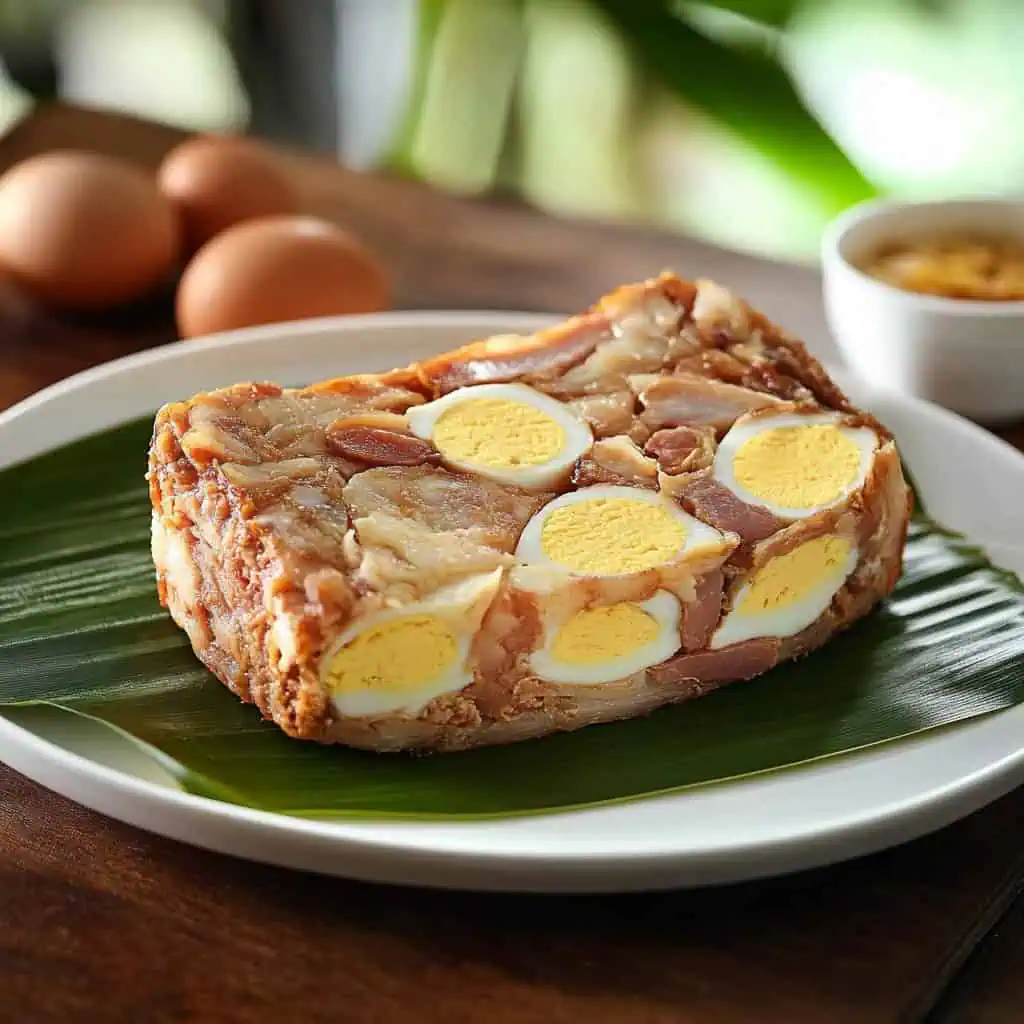









Comments
No Comments